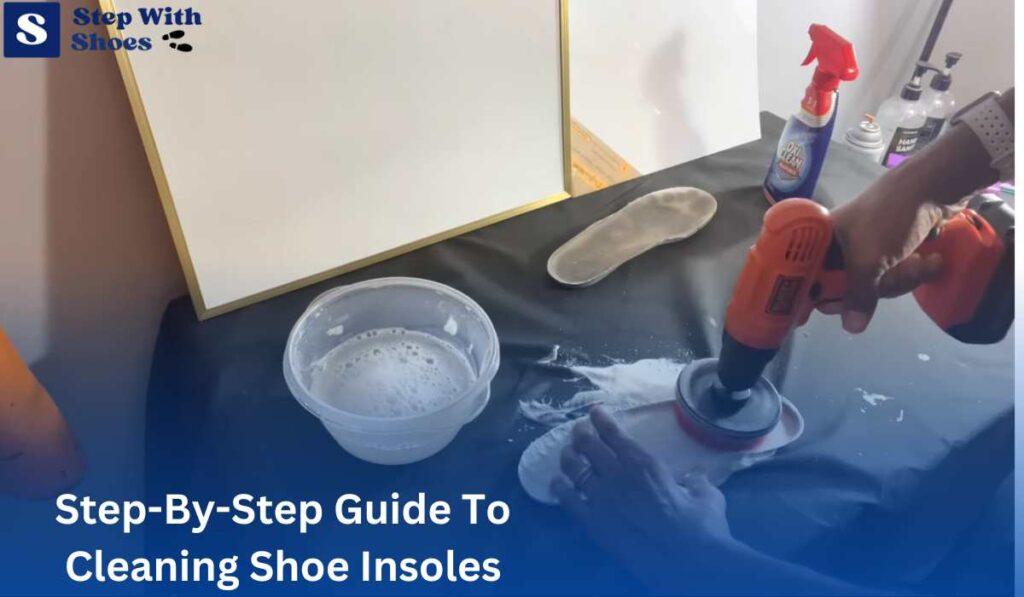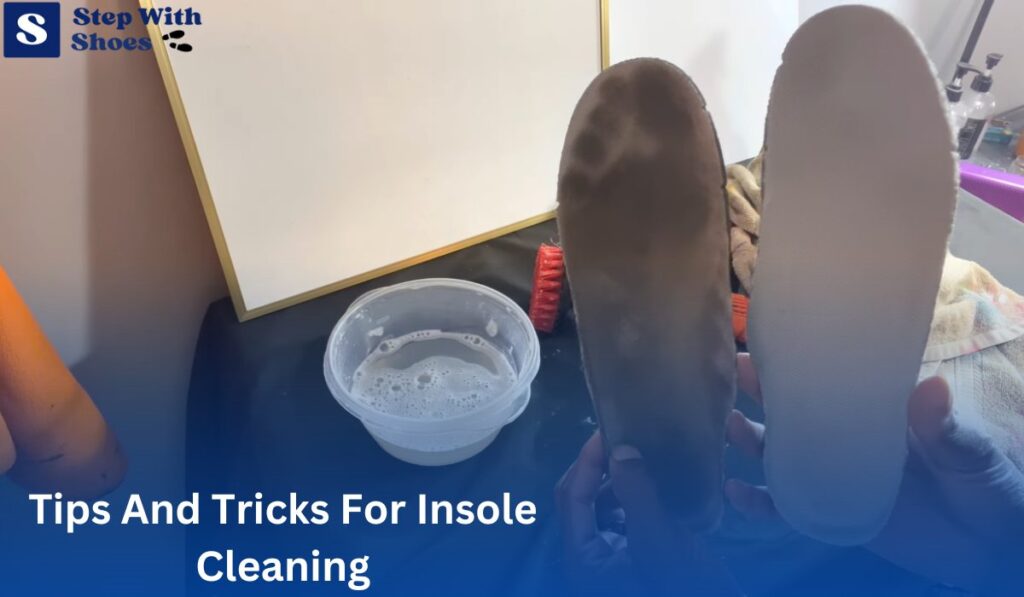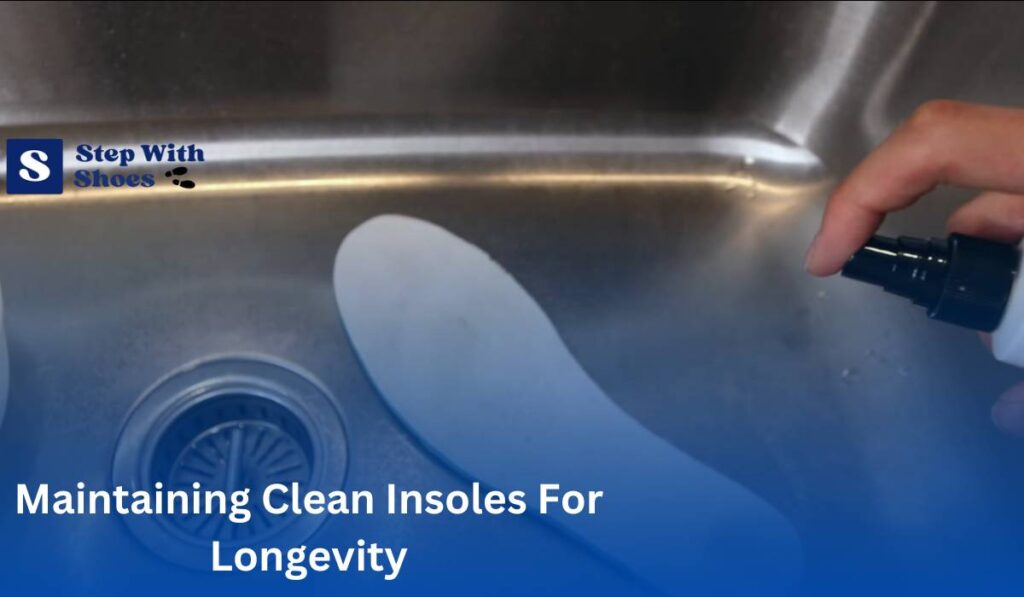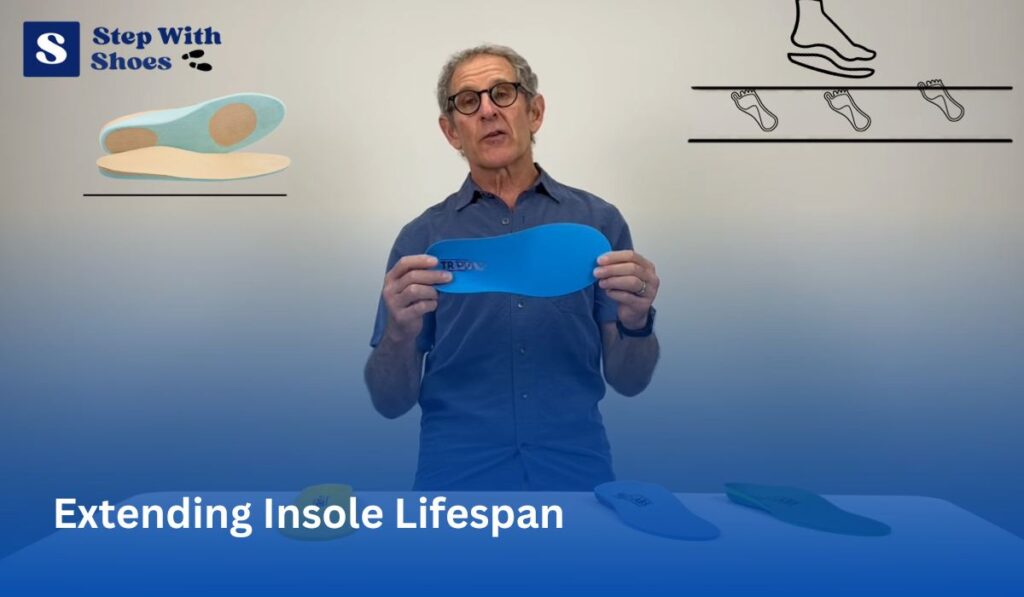To clean shoe insoles, remove them from the shoes and gently scrub them with a mixture of mild detergent and water. Rinse well, then air dry before putting them back in the shoes.
When it comes to keeping your shoes fresh and free from odor, cleaning the insoles is essential. Over time, dirt, sweat, and bacteria can accumulate on the insoles, causing them to smell unpleasant. Fortunately, cleaning the insoles is a simple process that can be done at home.
By removing the insoles from the shoes and scrubbing them with a mixture of mild detergent and water, you can effectively remove dirt and odor. After rinsing them thoroughly, allow the insoles to air dry before placing them back in the shoes.
Understanding The Importance Of Clean Shoe Insoles
Neglected shoe insoles can easily become a breeding ground for bacteria, causing unpleasant odors and potentially leading to foot health issues. Regularly cleaning and maintaining your shoe insoles is an essential part of overall foot care. Let’s dive into why clean shoe insoles matter and the impact of dirty insoles on foot health.
Why Clean Shoe Insoles Matter
- Prevents unpleasant odors: Over time, sweat and bacteria can accumulate on shoe insoles, resulting in a pungent smell. By regularly cleaning your insoles, you can eliminate these odors and keep your shoes smelling fresh.
- Increases the lifespan of your shoes: The accumulation of dirt and debris on insoles can cause them to deteriorate faster. Cleaning your insoles regularly can help remove these particles, extending the lifespan of your shoes.
- Improves overall hygiene: Just like washing your clothes, cleaning your shoe insoles is crucial for maintaining good personal hygiene. By keeping your insoles clean, you reduce the risk of bacterial and fungal infections, promoting healthier feet.
The Impact Of Dirty Insoles On Foot Health
- Causes foot odor: When sweat and bacteria combine on dirty insoles, it creates an unpleasant odor. This can be embarrassing and affect your self-confidence, especially in social situations. Regularly cleaning your insoles helps prevent the development of foot odor.
- Increases the risk of fungal infections: Dirty insoles provide an ideal environment for fungal infections to thrive. Fungi such as athlete’s foot can cause itching, redness, and discomfort. Regularly cleaning your insoles can help minimize the risk of such infections.
- Worsens existing foot conditions: If you have pre-existing foot conditions such as plantar fasciitis or flat feet, dirty insoles can exacerbate the pain and discomfort associated with these conditions. Maintaining clean insoles can help alleviate these symptoms.
- Affects overall foot health: Dirty insoles can lead to skin irritation, blisters, and calluses. These issues can make walking uncomfortable and hinder your daily activities. By keeping your insoles clean, you can promote better foot health and prevent these problems.
Taking the time to clean your shoe insoles regularly is a small but crucial step in maintaining overall foot hygiene. By understanding the importance of clean insoles and the impact of dirty ones on foot health, you can ensure that your feet feel and smell their best.
Identifying The Different Types Of Shoe Insoles

When it comes to cleaning your shoe insoles, it’s important to know what type of insole you’re working with. Different materials and designs require different cleaning methods to ensure they are thoroughly cleaned without causing any damage. Let’s take a closer look at understanding the materials used and determining the type of insole in your shoes.
Understanding The Materials Used
- Foam insoles: Foam insoles are the most common type and are typically made from a soft, cushiony material. Here are some key points to know about cleaning foam insoles:
- Remove the insoles from the shoes before cleaning.
- Gently brush off any loose dirt or debris.
- Fill a basin with warm water and add a mild detergent.
- Place the insoles in the soapy water and use a soft brush to scrub them gently.
- Rinse thoroughly with clean water and allow them to air dry completely before placing them back in your shoes.
- Gel insoles: Gel insoles are designed to provide additional cushioning and support. Here’s how to clean gel insoles effectively:
- Remove the gel insoles from your shoes before cleaning.
- Use a damp cloth or sponge to wipe away any surface dirt.
- If there are any stains or sticky residue, apply a small amount of mild soap and gently scrub with a soft brush.
- Rinse off the soap thoroughly with clean water.
- Let the gel insoles air dry completely before reinserting them into your shoes.
- Leather insoles: Leather insoles offer a stylish and comfortable option for footwear. Here are the key points for cleaning leather insoles:
- Remove the leather insoles from your shoes.
- Wipe away any loose dirt or debris with a soft cloth or brush.
- Apply a small amount of leather cleaner to a clean cloth and gently rub it into the insoles.
- Wipe off any excess cleaner and allow the insoles to air dry.
- Once dry, you can apply a leather conditioner to keep them soft and supple.
Determining The Type Of Insole In Your Shoes
- Shoe manufacturer information: Check the packaging or label that came with your shoes. Oftentimes, the manufacturer will provide information about the type of insole used.
- Visual inspection: Take a look at your insoles and observe their color, texture, and overall appearance. This can give you clues about the material used. For example, foam insoles usually have a more porous and cushiony texture, while gel insoles appear clear and squishy.
- Comfort and support: Pay attention to how your shoes feel when you wear them. Different types of insoles offer varying levels of comfort and support. Gel insoles, for instance, provide excellent shock absorption, while foam insoles offer cushioning.
- Online research: If you’re unsure about the type of insole in your shoes, you can also conduct some online research. Many shoe brands provide detailed information on their websites or forums about the specific insoles they use.
By understanding the materials used in shoe insoles and determining the type of insole in your shoes, you can ensure that you clean them properly and maintain their longevity. Remember to follow the recommended cleaning methods for each type of insole to keep your shoes fresh and odor-free.
Step-By-Step Guide To Cleaning Shoe Insoles

Shoe insoles can accumulate dirt, odor, and bacteria over time, making them unpleasant to wear. Knowing how to clean shoe insoles is essential not only to maintain their freshness but also to extend their lifespan. In this step-by-step guide, we will walk you through the process of cleaning your shoe insoles effectively.
So let’s get started!
Removing Insoles From Shoes
Before you can clean your shoe insoles, it’s important to remove them from your shoes. Follow these simple steps:
- Take out the shoelaces and open up the shoe.
- Gently pull out the insoles from the shoes.
- If they are glued in, be careful not to damage them while removing them.
Preparing A Cleaning Solution
Once the insoles are removed, it’s time to prepare a cleaning solution. Here’s how you can do it:
- Fill a basin or tub with warm water.
- Add a mild detergent or shoe cleaner to the water.
- Mix the solution well until it creates a soapy mixture.
Handwashing Insoles
Handwashing is a gentle method to clean shoe insoles while preserving their structure. Follow these steps for handwashing your insoles:
- Submerge the insoles in the cleaning solution.
- Use a soft brush or cloth to scrub away any dirt or stains.
- Pay extra attention to the areas that come in direct contact with your feet.
- Rinse the insoles under running water to remove any residue.
Machine Washing Insoles
If the care instructions on your shoe insoles allow it, you can also clean them in a washing machine. Here’s what you need to do:
- Place the insoles in a mesh laundry bag to protect them during the wash cycle.
- Use a delicate or gentle cycle with cold water.
- Avoid using bleach or harsh detergents that can damage the insoles.
- Once the cycle is complete, remove the insoles from the bag.
Drying Insoles Properly
Properly drying your shoe insoles is crucial to prevent mold and mildew growth. Follow these steps to ensure effective drying:
- Gently squeeze out excess water from the insoles.
- Place them in a well-ventilated area away from direct sunlight.
- Avoid using heat sources like radiators or hair dryers, as they can warp the insoles.
- Let them air dry completely before placing them back in the shoes.
By following these simple steps, you can keep your shoe insoles clean and fresh, ensuring maximum comfort and durability. Remember to clean your insoles regularly to maintain good foot hygiene and prevent odors. Enjoy the renewed freshness and comfort that clean shoe insoles can provide!
Tips And Tricks For Effective Insole Cleaning

Cleaning shoe insoles is an essential task for maintaining hygiene, removing stains and odors, and preventing bacterial growth. With proper cleaning techniques and the right tools, you can keep your shoe insoles fresh and odor-free. Here are some tips and tricks to help you effectively clean your shoe insoles:
Using Natural Cleaning Solutions
Using natural cleaning solutions is not only eco-friendly but also safer for your health. Here are some effective natural cleaning solutions to keep your shoe insoles clean:
- White vinegar: Mix equal parts of white vinegar and water. Dampen a cloth or sponge with the mixture and gently scrub the insoles. Allow them to air dry before placing them back in your shoes. White vinegar helps eliminate odors and kills bacteria.
- Baking soda: Sprinkle baking soda liberally over the insoles and let it sit overnight. This will help absorb bad odors. Vacuum or brush off the baking soda in the morning. You can also create a paste by combining baking soda and water and scrubbing the insoles with it.
- Tea tree oil: Add a few drops of tea tree oil to warm water and use a cloth or sponge to wipe down the insoles. Tea tree oil has natural antibacterial properties, making it effective in killing odor-causing bacteria.
- Lemon juice: Squeeze fresh lemon juice onto a cloth or sponge and gently rub it on the insoles. Lemon juice acts as a natural deodorizer and helps eliminate unpleasant smells.
Removing Stubborn Stains And Odors
Despite regular cleaning, shoe insoles can accumulate stubborn stains and persistent odors. Here’s how you can tackle them effectively:
- Spot cleaning with mild soap: If the insoles have stains, use a mild soap diluted with water to spot-clean the affected areas. Gently scrub the stains using a cloth or soft-bristled brush. Rinse thoroughly and allow the insoles to dry completely.
- Odor-neutralizing sprays: If the insoles still emit unpleasant odors after cleaning, you can use odor-neutralizing sprays specifically designed for shoes. These sprays help eliminate odors and keep your insoles smelling fresh.
- Machine washing (if applicable): Before attempting machine washing, check the care instructions of your shoe insoles. If they are machine-washable, place them in a laundry bag and wash them on a gentle cycle with mild detergent. Air dry the insoles afterward.
Preventing Bacterial Growth And Foul Odors
To prevent bacterial growth and foul odors from recurring, here are some preventive measures you can take:
- Regular cleaning: Make it a habit to clean your shoe insoles regularly. Follow the cleaning techniques mentioned above to keep them fresh and odor-free.
- Alternate insoles: Consider having multiple pairs of insoles for your shoes. Alternating between them allows each pair to dry out completely, reducing the risk of bacterial growth and odors.
- Use moisture-wicking socks: Moisture-wicking socks can help absorb sweat and keep your feet dry. This, in turn, reduces the moisture that can contribute to odor-causing bacteria.
- Allow proper ventilation: After wearing your shoes, remove the insoles and allow them to air out. This helps in moisture evaporation and prevents bacterial buildup.
By implementing these tips and tricks, you can effectively clean your shoe insoles, remove stubborn stains and odors, and prevent bacterial growth and foul smells. Keeping your shoe insoles clean and fresh will enhance both your comfort and overall foot hygiene.
So, give your insoles the attention they deserve and enjoy the benefits of clean and odor-free footwear.
Maintaining Clean Insoles For Longevity

Keeping your shoe insoles clean is essential not only for hygiene but also for prolonging their lifespan. Regular cleaning, proper storage, and timely replacement are essential components of maintaining clean insoles. By following these simple steps, you can ensure that your shoe insoles stay fresh and comfortable for longer, saving you money and preventing odors and discomfort.
Regular Cleaning Schedule
To keep your shoe insoles fresh and clean, it’s important to establish a regular cleaning routine. Here are some key points to consider:
- Remove the insoles from your shoes before cleaning them.
- Check the manufacturer’s instructions for specific cleaning recommendations.
- If the insoles are washable, gently hand wash them using mild soap and warm water.
- Thoroughly rinse the insoles to remove any soap residue.
- Air dry the insoles naturally, avoiding direct heat sources, which can damage the material.
- Once dry, use a soft brush to fluff up the fibers and restore the cushioning.
Remember, a regular cleaning schedule will not only keep your insoles clean but also maintain their effectiveness and lifespan.
Storing Shoes And Insoles Properly
Proper storage of shoes and insoles is crucial to preserve their cleanliness and condition. Here are some tips to consider:
- Store shoes in a cool, dry place to prevent the growth of mold and bacteria.
- Avoid storing shoes in plastic bags as they can trap moisture.
- Use shoe trees or stuff them with newspaper to help retain their shape and absorb excess moisture.
- When not in use, store insoles in a clean, ventilated area.
- Consider using breathable shoe bags to protect your shoes and insoles from dust and dirt.
By storing your shoes and insoles properly, you can prevent them from becoming a breeding ground for bacteria and odors, keeping them fresh and clean for longer.
Replacing Insoles When Necessary
No matter how well you maintain your insoles, there will come a time when they need to be replaced. Here are some indicators that it’s time to replace your insoles:
- Worn-out cushioning: If you notice a decrease in comfort or cushioning, it’s a sign that the insoles have worn out.
- Odor buildup: Even with regular cleaning, if the insoles still emit a persistent odor, it may be time for a fresh pair.
- Visible damage: Cracks, tears, or peeling are clear signs that the insoles are no longer in good condition.
- Reduced support: If your feet feel unsupported or you experience foot pain after wearing the shoes with the insoles, it’s time for a replacement.
Replacing worn-out or damaged insoles will not only improve comfort but also maintain the effectiveness of your shoes.
Maintaining clean insoles for longevity requires a regular cleaning schedule, proper storage, and timely replacement. By following these simple steps, you can ensure that your shoe insoles stay fresh, comfortable, and supportive for as long as possible. So, take care of your insoles, and they will take care of your feet!
Specialized Insole Cleaning
Orthotic Insoles – Special Care Tips
Orthotic insoles are designed to provide customized support and alleviate various foot problems. Cleaning them requires special care to maintain their functionality. To clean orthotic insoles, follow these specific tips:
When cleaning orthotic insoles, it’s crucial to check the manufacturer’s guidelines if available. Some orthotic insoles may have specific care instructions unique to their materials or designs. Follow those instructions for the best results.
Gel Insoles – Avoiding Harsh Chemicals
Gel insoles are known for their cushioning and shock-absorbing properties, making them a popular choice for individuals seeking comfort. However, cleaning gel insoles requires a gentle touch to avoid damaging the gel. Here’s how to clean them safely:
Avoid Harsh Chemicals: Harsh chemicals, including bleach and strong cleaning agents, should be avoided when cleaning gel insoles. These chemicals can break down the gel material, reducing its effectiveness and comfort. Instead, opt for mild, soapy water and a soft cloth or sponge for cleaning.
Gentle Scrubbing: To remove stains or dirt, gently scrub the surface of the gel insoles with a soft cloth or sponge. Avoid abrasive materials or excessive force, as they can cause damage.
Leather Insoles – Cleaning and Conditioning
Leather insoles provide a touch of elegance and comfort to your footwear but require proper cleaning and conditioning to maintain their quality and durability. Here’s how to clean and condition leather insoles:
Cleaning: Start by gently brushing off loose dirt and debris from the insoles. Then, dampen a soft cloth with warm, soapy water and wipe the insoles clean. Be careful not to oversaturate the leather, as excessive moisture can lead to damage. After cleaning, allow the insoles to air dry naturally.
Conditioning: Leather insoles benefit from occasional conditioning to keep them supple and prevent cracking. Use a leather conditioner that is specifically designed for insoles. Apply it sparingly, following the product’s instructions, and allow it to penetrate the leather. Wipe off any excess conditioner and allow the insoles to air dry.
By adhering to the prescribed care guidelines for orthotic, gel, and leather insoles, you can effectively prolong their lifespan and preserve their distinctive characteristics. Regular cleaning and maintenance are essential to sustain the advantages and comfort provided by these specialized insoles over an extended duration.
Extending Insole Lifespan

Protective Measures
To extend the lifespan of your shoe insoles, consider taking the following protective measures:
- Insole Protectors: These are thin, adhesive pads that you place on top of your insoles. They add an extra layer of protection against friction, moisture, and odors, especially if you sweat excessively or experience wear from your shoes rubbing against the insoles. Insole protectors are available in various materials and can be replaced when they wear out.
- Moisture-Wicking Socks: Invest in high-quality, moisture-wicking socks. They help keep your feet dry by drawing sweat away from your skin, reducing the moisture absorbed by your insoles. Look for socks made from breathable materials like merino wool or synthetic blends.
Storing Insoles Properly
Proper storage is crucial for extending the life of your insoles. Here’s how to store them effectively:
- Allow for Air Circulation: When you remove insoles from your shoes, let them air out before storing them. This prevents moisture buildup and odors.
- Organize and Label: If you have multiple pairs of insoles for different shoes, label them or keep them organized in separate containers or plastic bags. This makes it easy to identify and locate the right pair when needed.
- Use Dedicated Storage Solutions: Consider investing in a dedicated insole storage box or pouch designed to protect insoles from dust and damage. If you don’t have these options, a clean shoebox or a small container with good ventilation can work well.
- Avoid Direct Sunlight and Heat: Store your insoles in a cool, dry place away from direct sunlight and heat sources to prevent material damage or warping.
By implementing these protective measures in conjunction with appropriate storage practices, the longevity of your shoe insoles can be significantly extended. This not only results in cost savings from frequent replacements but also guarantees the continued provision of comfort and support by your shoes for an extended duration.
Frequently Asked Questions Of How To Clean Shoe Insoles
How Often Should I Clean My Shoe Insoles?
It is recommended to clean your shoe insoles every 2-3 months, depending on usage. Regular cleaning prevents odor-causing bacteria buildup and maintains cushioning and support.
What Is The Best Method To Clean Shoe Insoles?
To clean shoe insoles, remove them from the shoes and gently scrub them with a mixture of mild soap and warm water. Rinse thoroughly, and let them air dry completely before placing them back in the shoes.
Can I Machine Wash My Shoe Insoles?
In most cases, it is not recommended to machine wash shoe insoles as it may damage the materials and affect their performance. Hand washing is a safer option to maintain their quality and prolong their lifespan.
How Do I Get Rid Of Odor In Shoe Insoles?
To eliminate odor, sprinkle baking soda or cornstarch on the insoles and let them sit overnight. The powder absorbs moisture and odor. Alternatively, you can also use antibacterial sprays specifically designed for shoe insoles.
Can I Use Bleach To Clean My Shoe Insoles?
No, using bleach is not recommended as it can damage the materials and cause discoloration. Stick to mild soap and water or specialized shoe cleaning products to ensure the longevity and performance of your insoles.
What Should I Do If My Shoe Insoles Are Damaged?
If your shoe insoles are damaged, it is advisable to replace them. Damaged insoles can compromise the comfort and support they provide, leading to discomfort and potential foot problems.
Conclusion
After reading this comprehensive guide on how to clean shoe insoles, you are now equipped with the knowledge and techniques to keep your shoes fresh and odor-free. By following the steps outlined, you can effectively remove dirt, stains, and odor from your shoe insoles, extending their lifespan and ensuring your feet stay comfortable.
Remember to use gentle cleaning methods and avoid harsh chemicals that can damage the insoles. Regularly cleaning your shoe insoles will not only keep them hygienic but also contribute to the overall longevity of your shoes. So, take a few minutes out of your day to care for your shoe insoles, and you’ll be rewarded with fresh-smelling, comfortable footwear.
Say goodbye to smelly shoes and hello to clean, fresh insoles!


